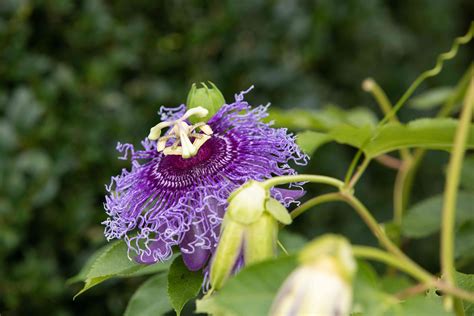How To Grow And Care For A 66. Passion Flower Plant
Passion Flower: Growing and Caring Tips Are you interested in learning how to grow a Passion Flower? Look no further! Passion Flower, also known as Passiflora, is a beautiful and exotic plant that originates from Central and South America. Passion Flower is a climbing vine that produces stunning and vibrant flowers that will add color and life to any garden or indoor space. Here are some tips for caring and growing a Passion Flower: Plant Attributes Passion Flower is considered a high-maintenance plant, so it is important to research the plant's specific care requirements before planting. Passion Flower prefers to be grown in a loamy, well-draining soil with a neutral pH level of around 6.5-7.5. Passion Flower also requires full sun exposure for optimal growth. Plant Care Passion Flower requires regular watering, especially during the first year of growth. However, it is important not to over-water the plant as this can lead to root rot. It is recommended to water Passion Flower once a week in dry climates and twice a week in humid climates. Passion Flower is also a heavy feeder, so it is important to fertilize every 2-4 weeks during the growing season. Pruning Pruning is an essential part of Passion Flower care as it promotes flowering and controls the plant's growth. Pruning is best done in early spring after new growth has appeared. Prune dead and diseased branches as well as any crossing branches to prevent them from competing for space and nutrients. Passion Flower can also be trained to grow on a trellis or wall for better aesthetic appeal. Propagation Passion Flower can be propagated through stem cuttings, division, or layering. Stem cuttings should be taken in the spring or early summer and should be taken from new, green growth. Dip the cuttings in a rooting hormone and place them in a potting mix with perlite. Keep the soil moist and in a bright, warm location until new growth appears. Potting & Repotting Passion Flower should be potted in a well-draining potting mix with peat moss, sand, and perlite. It is important to use a pot with drainage holes to prevent overwatering. Repotting should be done every 1-2 years in early spring, just before the growing season begins. Common Pests & Plant Diseases The most common pests that affect Passion Flower are scale insects, spider mites, and mealybugs. These pests can be controlled with neem oil or insecticidal soap. Passion Flower is also susceptible to fungal diseases such as powdery mildew and root rot, which can be prevented by proper watering and good air circulation. Common Problems One common problem with Passion Flower is that it may not flower if it does not receive enough sunlight. Another problem is that the flowers may drop prematurely if the plant is overwatered or underwatered. Lastly, Passion Flower may be affected by frost damage in areas with cold winters, so it is important to protect the plant during the winter months. In conclusion, Passion Flower is a beautiful and exotic plant that requires a bit of extra care but is well worth the effort. With proper plant care, you can enjoy the stunning and vibrant flowers of the Passion Flower vine in your garden or indoor space. 


www.pinterest.com
www.pinterest.com
www.thespruce.com



:max_bytes(150000):strip_icc()/how-to-grow-morning-glories-4125567-02-40e20a6df17b41d3a767733a3bc52741.jpg)
Post a Comment for "How To Grow And Care For A 66. Passion Flower Plant"